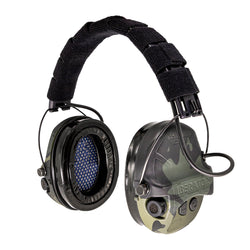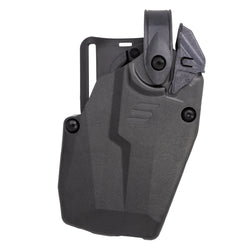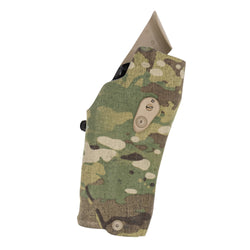The Safariland SAVES program isn’t just a list of names—it’s a testament to lives protected and second chances granted. Each member has a story, a moment when the right gear made all the difference. This series introduces you to those stories.
The Safariland SAVES Club highlights individuals who put their lives on the line in the line of duty and, in turn, had their lives saved by their gear. The installment today has the story of Katie Lawson of Oklahoma City Police, whose life was saved thanks to the Safariland IMPAC plates in the vest she was wearing.
BACKGROUND
Katie Lawson, then a 27-year-old patrol officer for the Oklahoma City Police Department, had been with the department about four years at the time of her SAVES call. Assigned to the overnight shift, she had taken two days off work to attend a friend’s wedding. She seriously considered taking that Sunday off work as well, but decided to take her shift to ease the burden on other officers.

THE CALL
About an hour into Katie’s shift on August 29, 2010, an assistance call came in from the Oklahoma County Sheriff’s Department. Katie responded as the call was in her district and she was the closest officer to the scene at the intersection of 38th & Miller. She initially thought the call involved a stolen vehicle, as the sheriff had tried to stop a Honda Civic that failed to stop. The vehicle finally stopped about a mile into the call, at 2705 NW 38th.
Katie first approached the deputy on the driver’s side of his patrol car to obtain more information on the call. She then transitioned to the passenger side of the patrol car to approach the Civic from the rear passenger side, treating the stop like a felony stop.
The driver of the vehicle did not heed the deputy’s directions to exit the vehicle and the like when Katie noticed the occupants of the house come out and attempted to approach the car. The adult female and two younger males, aged 16 and 18, complied with Katie’s instructions to stay back.
The older male acted as a translator, speaking Spanish to the driver, and got the driver to exit the car. The deputy had the man move away from the vehicle and sit in the grass, where it was confirmed that he was intoxicated. The driver was arrested and placed in the back of the deputy’s patrol car.
Katie then approached the adult female to get more information, but her English was very broken. The teenagers translated again and revealed that the driver was their father, who didn’t speak English. Katie said the boys were very polite and helpful, answering all her questions, but didn’t seem too shocked by the father’s arrest. Katie relayed the driver’s information to the Deputy to run through their system for any background information.

While the deputy was trying to obtain records, Katie stayed in the yard answering questions from the teenagers. They wanted to know where their father would be going, where the car would be impounded, and other similar questions. The deputy was unable to retrieve any information on the driver, so he asked Katie to run the information through their system since the two agencies utilize different databases. She went to her patrol car and ran the check, discovering prior arrests and citations, including domestic issues and DUI.
She handed the information to the deputy and the wrecker showed up to tow the Civic. With everything under control, the deputy released Katie from the scene. She chatted a bit more before deciding to leave. As she drove northbound on Miller Avenue, she realized she needed to document her activity for her log and plan out the rest of the night, and prepared to stop in a nearby parking lot.
Movement caught her eye on her left in the parking lot just south of the intersection of 39th & Miller. The suspect, whose back was to her patrol car, jumped as if he was startled when he spotted her. The corner of the entry to the parking lot she pulled into was dimly lit, so she couldn’t see fine details. Before she was able to call in the suspect or get out, he turned towards her with his arms in front of his body. That’s when she saw the long barrel of the rifle pointed in her direction. Katie felt like she froze and wondered if she was actually seeing what she thought she saw.
The suspect raised the rifle and immediately opened fire on her car. Katie knew she needed to return fire. She leaned over in her vehicle to move her head out of the line of fire as the suspect advanced, continuing to shoot.
She doesn’t remember unholstering her pistol with the different retention features, attributing the ability to her muscle memory and training. She aimed her pistol out the window and fired eleven rounds toward the suspect. As she began firing, he disengaged from the scene and ran west back along a fence line toward the original scene.
Katie knew she had been shot at least once, feeling a tingling sensation in her left leg. She used her vehicle radio to call the shooting into dispatch. She thought to herself that she needed to get out and run after the suspect, to either catch him or at least gather the necessary information to locate him.
She was able to get her door open and get out of the car. She tried to run after the suspect, but as she did her feet felt like bricks were attached to her feet and she couldn’t get her legs to work. Standing outside her car, Katie noticed the eerie silence and realized no sires were approaching. She couldn’t understand why no one was coming yet.

Concerned and was dizzy, Katie knew that if she passed out, she might not wake up again. She tried to call the shooting in again, using her handheld radio. She was able to get confirmation from dispatch on the second call.
Katie, with a bloody face, looked back south towards the original call location and saw a citizen on the corner, who was obviously shaken by what happened. The citizen asked if she was ok and told her they’d call 911 for her. She thought it was funny to call 911 when she had a direct line, but she appreciated the concern. The citizen was able to get the deputy’s attention from the original scene. The deputy had heard the shots but was providing protection for himself and the wrecker driver.
The deputy got to Katie as other officers arrived. They pulled her to safety, providing cover. Katie gave basic information on the suspect to responding units then removed her shirt and vest to search her for other injuries. She knew her face was bloody, but didn’t know exactly where the injury was, or the extent of her other injuries. Responding officers set a perimeter and deployed K-9 and a helicopter unit to track the suspect.
After Katie was transported to the hospital, a ground search for the shooter began. The family members from the original call were outside, so they were placed in patrol cars as potential witnesses. A citizen reported seeing the suspect run across the back of their property and into the family’s home. A tactical team was called in to search the house for the shooter. The shooter wasn’t found in the house, but a rifle magazine was seen on a table.
Homicide was brought in to investigate the shooting, as they always do with officer-involved shootings. They brought the family down to the police headquarters and placed them in separate rooms. The boys spoke in Spanish through the wall to each other, making sure they had disposed of the evidence, had washed their hands, and advising one another not to speak to the police.
A citizen on the scene also reported that prior to the shooting, they heard the boys speak Spanish asking each other how they were going to get their father out. It was found out that the boys went into the house and the older of the two got an AR-style rifle, preparing to come around the back of the house to ambush both Katie and the deputy, kill them, and free their father.
The boys didn’t know Katie had left the scene. During the encounter, the suspect had shot 26 rounds, 23 of them hitting Katie’s patrol car, and six hitting her. The older boy ran through his backyard and back to the house, stashed the gun under the floorboards of the house, changed his shirt, and came back out front of the house acting like nothing had happened. Another citizen had reported that during the shooting they saw the mother approach the deputy’s car and reach for the door handle where her husband was detained.

RECOVERY & LIFE AFTER
At the hospital a thorough examination revealed that Katie was shot six times. In addition to the buttock/sciatic shots she knew about, she had taken rounds to her upper abdomen, back, right calf, and a shot that grazed her right cheek and pierced her right ear. Katie had assumed the injury to her right cheek and ear had happened first when she was trying to get out of the line of fire.
A plastic surgeon was able to attend to Katie’s facial injuries, closing up her cheek and ear wounds. For the two buttock wounds, doctors closed up the two wounds as a single larger one, since the two rounds entered close to each other. The calf injury was a bit more intense with a small entry hole and larger exit hole, which the doctors allowed to recover and heal naturally.
Several of the rounds that hit Katie are assumed to have gone through her vehicle in one place or another. Thankfully they did, because Katie received a center mass shot in the upper abdomen and her back. The ABA® HP level II vest she was wearing was not rated for the .223 round, but because the car slowed the round’s velocity, Katie just had burned skin and bruising from the impact. It could have been so much worse.
Katie was released from the hospital after three days and moved back home with her mom for the next month to recover. With the help of her mom and the home health aides, she was able to return to light work after just four months. She worked two months of light duty in the Crimes Against Children unit before she went back to Patrol.
Katie relayed to me her desire to return to Patrol. While in the hospital, her Chief came to visit her, and she said at that moment, she would go back. As she put it to me in the interview, she made the choice to prove to herself that she could still be a police officer.
“I didn’t want the evil act of somebody else changing my career path. …I wanted the decision to come off the streets to come from me and not based on that the evil act.”
Katie was determined that the trauma of the event wouldn’t hold her back. Back on patrol one night, she returned to the scene of her shooting with other officers. While there, she was able to recall some other details, and ultimately, the visit helped in her healing journey.
The older boy was interviewed by the FBI for his roles in the shooting. Both boys have been convicted of their crimes and are currently incarcerated. Katie has had the fortitude to push through and return to the job she loves. She credits her recovery to God’s grace in her life.
Katie has moved on from patrol and worked 8.5 years on what she called an IMPACT Team, where she predominately investigated drug offenses. She called those years on the team the most fun she has had thus far in her career.
In 2020, Katie was informed about a position in the department’s newly created Wellness Unit. After initially struggling with the decision to put in for the spot, she went for it. Katie ultimately wanted to give back to all of those who helped her plus provide her an opportunitey to pay it forward to future employees. She has been there for the last five years and doesn’t regret the decision at all.









